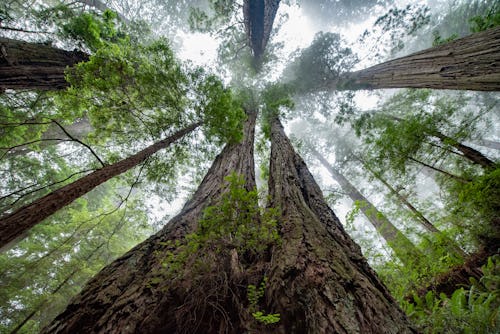
In California, there is a 523-acre area known as Andersonia West. Tucked away between Sinkyone Wilderness State Park and the Usal Forest in Mendocino County, it houses some of the last ancient redwoods — giant trees that have been growing in the region for as many as 20 million years. For the last 200 years, colonizers have taken those lands away from Native groups and unceremoniously cut them down, upending history and upsetting natural ecosystems. Now, at least on the patch of land in California’s Lost Coast, that ends.
The week, a conservation group called Save the Redwoods League transferred ownership of the forestland over to the InterTribal Sinkyone Wilderness Council, a group of 10 Northern California tribal nations. The collective will take ownership over the land, serving as its primary protectors as they seek to preserve the land and its delicate ecosystem. The council have renamed the forest Tc'ih-Léh-Dûñ, a Sinkyone phrase meaning “fish run place.” The change is meant to serve as “an act of cultural empowerment and a celebration of Indigenous resilience,” and to signify that the land is sacred, according to the group.
The planned transfer of the land has been two years in the making — and hundreds of years too late. It started in 2020, when the Save the Redwoods League initially purchased the land. That transaction, which cost $3.55 million, was funded by Pacific Gas & Electric Company, which has been responsible for multiple deadly and destructive wildfires that have plagued California in recent years. The funding is part of the company’s participation in conservation programs meant to mitigate the massive amount of damage that it has done. With PG&E’s financial backing, the conservation group then transferred ownership over the forestland to InterTribal Sinkyone Wilderness Council.
Now under native protection, Tc'ih-Léh-Dûñ will be preserved from ongoing construction and encroachment from the timber industry. The group will oversee the land, which contains about 200 acres of redwoods and 1.5 miles of Anderson Creek, and serves as home to a number of endangered species including the northern spotted owl, steelhead trout, coho salmon, marbled murrelet, and yellow-legged frog.
Transfers like this don’t just preserve the land itself, but also the rightful legacy of these sacred areas by returning stewardship to the Native populations that preserved them for centuries before colonizing forces stripped them away. Indigenous people are essential protectors of the planet. While they represent about 5% of the world’s population, they manage nearly a quarter of all land on Earth — and that land holds about 80% of the planet’s biodiversity.
Techniques developed by Indigenous populations to manage and conserve land have been utilized for centuries and are still effective to this day. Colonizers, believing they knew better, often disregarded these strategies for preservation, with far worse results. As we fight to combat climate change and preserve the planet as a whole, it’s time we re-empower the people who have a history of protecting the land. Giving them back what is rightfully theirs is a good start.







